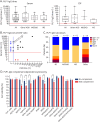Conformational Antibodies to Proteolipid Protein-1 and Its Peripheral Isoform DM20 in Patients With CNS Autoimmune Demyelinating Disorders.
Masciocchi S, Businaro P, Greco G, Scaranzin S, Malvaso A, Morandi C, Zardini E, Risi M, Vegezzi E, Diamanti L, Bini P, Siquilini S, Giannoccaro MP, Morelli L, Liguori R, Patti F, De Giuli V, Portaccio E, Zanetta C, Bergamoni S, Simone AM, Lanzillo R, Bruno G, Gallo A, Bisecco A, Di Filippo M, Pauri F, Toriello A, Barone P, Tazza F, Bucello S, Banfi P, Fabris M, Volonghi I, Raciti L, Vigliani MC, Bocci T, Paoletti M, Colombo E, Filippi M, Pichiecchio A, Marchioni E, Franciotta D, Gastaldi M; Neuroimmunology platform study group (PNI).
Masciocchi S, et al.
Neurol Neuroimmunol Neuroinflamm. 2025 Mar;12(2):e200359. doi: 10.1212/NXI.0000000000200359. Epub 2025 Jan 17.
Neurol Neuroimmunol Neuroinflamm. 2025.
PMID: 39823554
Free PMC article.

